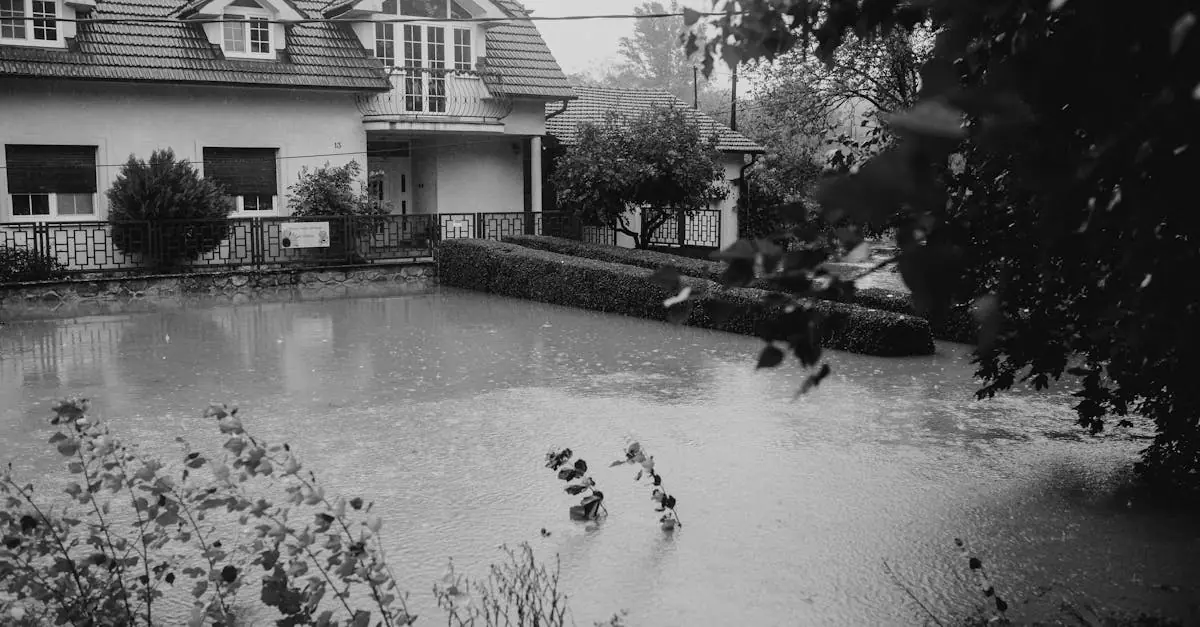Table of Contents
ToggleWhen it comes to homeownership, the roof is often the unsung hero, bravely shielding against rain, snow, and the occasional squirrel invasion. But what happens when that trusty roof takes a hit? Homeowners insurance might sound like a magic wand that covers all, but it’s not always a fairy tale ending.
Understanding Homeowners Insurance
Homeowners insurance provides financial protection against certain damages to a home. Coverage options vary significantly among policies. Most standard policies cover damages caused by fire, theft, and certain weather conditions. Roof damage may or may not fall under these coverages.
Exclusions exist that homeowners must understand. For example, policies typically avoid covering wear and tear or maintenance-related issues. Damage from flooding generally requires a separate flood insurance policy. Understanding specific exclusions is crucial when evaluating coverage.
Coverage limits impact the amount received for repairs. Some policies impose caps on certain types of damage, which may not cover full replacement costs. Homeowners should review their policy limits periodically to ensure they align with current replacement costs.
Deductibles also affect claims. A deductible is the amount homeowners pay out-of-pocket before insurance kicks in. Policies with higher deductibles often have lower premiums, but this can lead to higher costs during a claim.
Factors like the age of the roof and building materials matter as well. Older roofs may incur higher insurance rates due to the increased likelihood of damage. Many insurance companies consider roof type and condition when determining policy eligibility.
Staying informed about homeowners insurance helps mitigate risks associated with roof damage. By understanding coverage options, exclusions, coverage limits, and deductibles, homeowners can make informed decisions. Regular policy reviews ensure adequate protection as circumstances change.
Factors That Affect Coverage
Understanding what affects homeowners insurance coverage is essential for homeowners. Many elements influence coverage decisions, particularly when it comes to roof damage.
Types of Roof Damage Covered
Standard policies generally cover roof damage caused by specific perils such as fire, hail, and windstorms. It’s important to note that this coverage often applies only under specific conditions defined in the policy. For example, if a storm causes a tree to fall onto a roof, insurance may cover repair costs. Additionally, sudden and accidental damage tends to be covered as long as it fits within the policy’s terms. Homeowners should review their policies thoroughly to identify any requirements or limitations associated with covered events.
Types of Roof Damage Not Covered
Exclusions also play a significant role in determining coverage for roof damage. Wear and tear typically falls outside the scope of standard homeowners insurance. Homeowners may find that maintenance issues like missing shingles or leaking roofs resulting from neglect won’t be covered. Furthermore, damage from floods usually requires a separate flood insurance policy, as it’s often excluded from basic homeowners insurance. Understanding these exclusions helps homeowners remain informed about potential risks and financial liabilities.
Steps to File a Claim
Filing a claim for roof damage can seem daunting, but following the right steps ensures a smoother process.
Documenting Roof Damage
Start by taking clear photos of all visible damage, including shingles, leaks, and structural issues. Collect any relevant documentation, such as maintenance records or previous repair invoices, which could support the claim. Keeping detailed notes about the damage event, including dates, weather conditions, and any witnesses, helps provide context. Using this information establishes a comprehensive view of the situation and reinforces the claim’s validity. Provide this documentation to the insurance company during the filing process to facilitate a quicker resolution.
Working with Insurance Adjusters
Communicate openly with the insurance adjuster assigned to the claim. They assess the damages and determine the coverage applicable to the situation. Prepare to answer questions about the roof’s condition and the events leading to the damage. Provide the previously documented evidence during this interaction, as it supports the claim and clarifies any uncertainties. Follow up after the assessment to ensure all necessary information is included in the report. Being proactive throughout this process can lead to faster claims processing and resolution.
Common Misconceptions
Confusion often arises about what homeowners insurance covers in terms of roof damage. Many believe that all types of roof damage are automatically included, but this is not accurate. Homeowners insurance primarily protects against specific events like fires or severe storms. Exclusions, such as normal wear and tear, often catch homeowners off guard.
Some homeowners assume that all roof damage is covered regardless of its cause. In reality, damage from neglect or lack of maintenance is typically not eligible for coverage. Many also overlook that flooding damages require a separate policy, leading to unexpected costs during repairs.
Another misconception involves the relationship between deductibles and claims. Homeowners may think their deductible is applied every time damage occurs, but it usually applies per incident. Realizing this can highlight the importance of understanding policy language and specifics regarding deductibles.
Homeowners frequently underestimate the impact of their roof’s age on coverage. Older roofs may not receive the same compensation or approval for claims as newer roofs due to increased risks. Some also believe that filing a claim automatically guarantees a payout, yet every claim is subject to investigation and approval based on policy details.
Another point of misunderstanding relates to factors affecting premium rates. Homeowners might think all roof types carry the same insurance costs, but premium rates vary based on material and location. Different roofing materials can lead to different policy pricing based on their risk profiles.
Staying informed about these misconceptions allows homeowners to make better decisions about their coverage. Periodic reviews of insurance policies also aid in recognizing any gaps in coverage related to roof damage, ensuring adequate protection.
Homeowners insurance can provide essential protection against certain types of roof damage but it’s crucial for homeowners to understand the specifics of their policy. Coverage often hinges on the cause of damage and the terms outlined in the policy. Exclusions like wear and tear can leave homeowners vulnerable to unexpected costs.
By regularly reviewing their insurance policies and staying informed about coverage limits and deductibles, homeowners can better prepare for potential roof damage. Being proactive in understanding what’s covered can make a significant difference when it comes time to file a claim. Ultimately, knowledge and preparation are key to ensuring adequate protection for one of the most vital components of a home.





